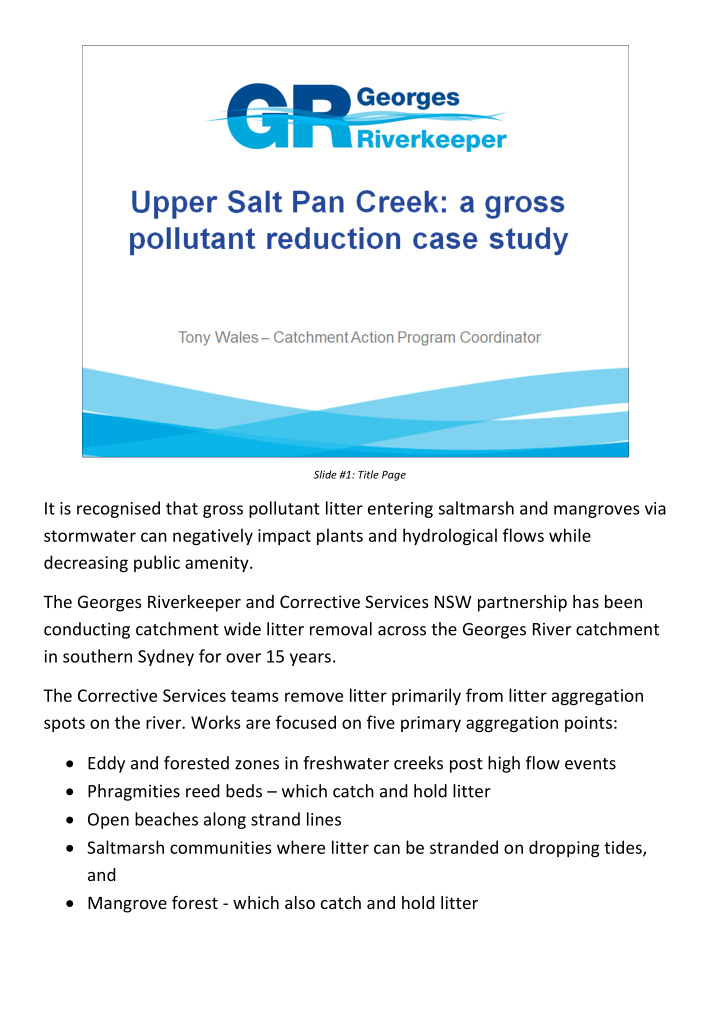



Slide #1: Title Page It is recognised that gross pollutant litter entering saltmarsh and mangroves via stormwater can negatively impact plants and hydrological flows while decreasing public amenity. The Georges Riverkeeper and Corrective Services NSW partnership has been conducting catchment wide litter removal across the Georges River catchment in southern Sydney for over 15 years. The Corrective Services teams remove litter primarily from litter aggregation spots on the river. Works are focused on five primary aggregation points: Eddy and forested zones in freshwater creeks post high flow events Phragmities reed beds – which catch and hold litter Open beaches along strand lines Saltmarsh communities where litter can be stranded on dropping tides, and Mangrove forest - which also catch and hold litter
Slide #2: Study Site Location The case study focused on the upper Salt Pan Creek sub-catchment in the Canterbury-Bankstown and Georges River local government areas. Prior to human modification, Upper Salt Pan Creek was an open tidal system dominated by saltmarsh with a lesser mangrove presence. The name Salt Pan Creek was derived from the extensive saltmarsh communities. Upper Salt Pan Creek is the area north of the Henry Lawson Drive bridge with two major urban stormwater inputs: The Gow Street stormwater canal draining Bankstown Shopping Centre to the north west, and Wiggs Road canal draining the suburbs of Punchbowl, Riverwood and Narwee to the east This case study will predominantly discuss the Gow Street GPT, installed in June 2015, as the data and impacts of the Wiggs Road GPT installed in November 2017 has been operative for too short a time period to be verifiable.
Upper Salt Pan Creek morphology has been significantly altered by the construction of the Henry Lawson Drive bridge in the lat e 1950’s and landfill practices in the 1960s and 70s. Today Upper Salt Pan Creek is close to a closed system with the Henry Lawson Drive bridge reducing the channel width by around 80% resulting is reduced tidal flows. This has resulted in heavy sedimentation of the waterways and mangrove incursion. Litter and rubbish aggregation in the Salt Pan Creek mangroves can reach epic proportions. Slide #3: Litter in Salt Pan Creek Mangroves Detailed records of litter removal from Salt Pan Creek started in 2011/12 when 6.7 tonne or litter was removed followed by 8.1 tonne in 2012/13. If you ask a council engineer how effective a GPT is they can tell you how many kilograms were removed from the GPT but they fail to differentiate between litter, organic matter and sediments.
Slide #4: Bandalong Gross Pollution Trap at Gow Street, Padstow When Canterbury-Bankstown Council installed a Bandalong GPT in June 2015 we were able to effectively measure the positive impacts solely on litter reduction (excluding organics and sediments) by analysing litter removal within the Upper Salt Pan Creek sub-catchment. The results are compared against the whole of river baseline statistics less the study site worksites statistics. A second Bandalong GPT was installed in the Wiggs Road, Riverwood stormwater canal in November 2017. The direct impact of the Wiggs Road GPT is difficult to analyse at this stage but its effectiveness is reflected in the overall results of litter reduction. As visits to work sites reflect available Corrective Services resources we analysed litter removal at the “per visit” metric rather than the annual aggregated metric.
Slide #5: Upper Salt Pan Creek Litter Removal (kilograms per site visit) The 2011/12 and 2012/13 results have been removed from the metric calculation as those two years were dealing with a back log of rubbish and the introduction of new work sites thus distorting their outputs. The average of the 2013/14 and 2014/15 years prior to the installation of the Gow Street GPT litter removal averaged 60.0 kilograms per visit while the post GPT installation from 2015/16 to year to date 2017/18 average litter removal averaged 34.7 kilograms per visit. A reduction of 42%. The success of the Gow Street and the Wiggs Road GPTs can be attributed to: An effective design of GPT in the Bandalong model Effective placement in a closed area (side of canal to side of canal) Good infrastructure around the GPT allowing regular clearing and maintenance of the device, and An overall strategic and effective project plan by Canterbury-Bankstown Council
Recommend
More recommend